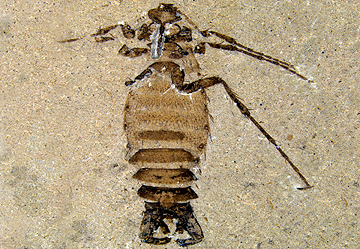Abstract
Preparation of a piece of amber is an inevitable step for any paleontologist working with this precious medium. To see the life-like detail of a biological inclusion, the fossil resin itself has to be trimmed to the minimum, then surfaces polished flat for viewing of the fossil, preferably from all sides. This concerns inclusions of any size, but the smallest—mites, collembolans, scale insects and others—are the most challenging to the abilities of the human hand. Making a millimeter-large cube of a brittle material containing an unscathed tiny fossil was feasible for only a few artists of amber preparation some ten years ago. Now, with tools and techniques having evolved since, the task is feasible for any attentive preparator after a few days of training. This paper is an account of our progress.
References
Azar, D. (1997) A new method for extracting plant and insect fossils from Lebanese amber. Palaeontology, 40 (4), 1027–1029.
Bisulca, C., Nascimbene, P.C., Elkin, L. & Grimaldi, D.A. (2012) Variation in the deterioration of fossil resins and implications for the conservation of fossils in amber. American Museum novitates, 3734, 1–19.
https://doi.org/10.1206/3734.2
Dunlop, J.A., Penney, D., Dalüge, N., Jäger, P., McNeil, A., Bradley, R.S., Withers, P.J. & Preziosi, R.F. (2011) Computed tomography recovers data from historical amber: an example from huntsman spiders. Die Naturwissenschaften, 98 (6), 519–527.
http://dx.doi.org/10.1007/s00114-011-0796-x
Fraquet, H. (1987) Amber. Butterworths gem books. Elsevier Science & Technology. Butterworth-Heinemann Ltd, Oxford, United Kingdom. 188 pp. [Cited after translation: Sutormina, N.E. (1990) Moscow, Mir Publ. 199 pp.]
Grandjean, F. (1949) Observation et conservation des très petits arthropodes. Bulletin du Muséum National d’Histoire Naturelle, 2e série, 21 (3), 364–369.
Heethoff, M., Helfen, L. & Norton, R.A. (2009) Description of Neoliodes dominicus n. sp. (Acari, Oribatida) from Dominican amber, aided by synchrotron x-ray microtomography. Journal of paleontology, 83 (1), 153–159.
Klimov, P.B. & Sidorchuk, E.A. (2011) An enigmatic lineage of mites from Baltic amber shows a unique, possibly female-controlled, mating. Biological Journal of the Linnean Society, 102, 661–668.
https://doi.org/10.1111/j.1095-8312.2010.01595.x
Krantz, G.W. & Walter, D.E. (2009) A Manual of Acarology. Third. Texas Tech University Press, Lubbock, Texas. 807 pp.
Nascimbene, P. & Silverstein, H. (2000) The preparation of fragile Cretaceous ambers for conservation and study of organismal inclusions. In: Studies on fossils in amber, with particular reference to the Cretaceous of New Jersey. Grimaldi, D. (Ed.). Backhuys, Leiden, Netherlands. pp. 93–102.
Perrichot, V., Nel, A. & Néraudeau, D. (2004) Two new wedge-shaped beetles in Albo-Cenomanian ambers of France (Coleoptera: Ripiphoridae: Ripiphorinae). European Journal of Entomology, 101, 577–581.
https://dx.doi.org/10.14411/eje.2004.081
Robin, N., Béthoux, O., Sidorchuk, E., Cui, Y., Li, Y., Germain, D., King, A., Berenguer, F. & Ren, D. (2016) A Carboniferous mite on an insect reveals the antiquity of an inconspicuous interaction. Current Biology, 26 (10), 1376–1382.
https://dx.doi.org/10.1016/j.cub.2016.03.068
Santiago-Blay, J.A. (2008) Lubricating jelly helps improve image clarity of inclusions entombed in amber and copal. Annales de la Société Entomologique de France, 44, 209–210.
https://doi.org/10.1080/00379271.2008.10697557
Schmidt, A.R., Jancke, S., Lindquist, E.E., Ragazzi, E., Roghi, G., Nascimbene, P.C., Schmidt, K., Wappler, T. & Grimaldi, D.A. (2012) Arthropods in amber from the Triassic Period. Proceedings of the National Academy of Sciences, 109 (37), 14796–14801.
https://dx.doi.org/10.1073/pnas.1208464109
Sellnick, M. (1918) Die Oribatiden der Bernsteinsammlung der Universität Königsberg i. Pr. In: Schriften der Physikalisch-ökonomischen Gesellschaft zu Königsberg i. Pr. B.G. Teubner, Leipzig und Berlin. pp. 21–42.
Sidorchuk, E.A. (2011) Preparation of six-sided micro-samples of Baltic amber for study of organismal inclusions. In: Amber Mining and Processing in Sambia, 12–14 May 2010. International Symposium Materials. Kostyashova, Z.V. (Ed.). Kaliningrad. pp. 47–53.
Sidorchuk, E.A. (2013) New technique for preparation of small-sized amber samples with application to mites. In: Insect Evolution in an Amberiferous and Stone Alphabet. Proceedings of the 6th International Congress on Fossil Insects, Arthropods and Amber. Azar, D., Engel, M.S., Jarzembowski, E., Krogmann, L., Nel, A. & Santiago-Blay, J.A. (Eds.). Brill, Leiden-Boston. pp. 189–201.
Sidorchuk, E.A. (2018) Mites as fossils: forever small? International Journal of Acarology, 1–12.
https://doi.org/10.1080/01647954.2018.1497085
Sidorchuk, E.A. & Behan-Pelletier, V.M. (2017) Megeremaeus cretaceous new species (Acari: Oribatida), the first oribatid mite from Canadian amber. The Canadian Entomologist, 149 (3), 277–290.
https://dx.doi.org/10.4039/tce.2017.8
Sidorchuk, E. & Bertrand, M. (2013) New fossil labidostomatids (Acari: Labidostomatidae) from Eocene amber and presence of an apustulate species in Europe. Acarologia, 53 (1), 25–39.
https://dx.doi.org/10.1051/acarologia/20132079
Sidorchuk, E.A., Bochkov, A.V., Weiterschan, T. & Chernova, O.F. (2018) A case of mite-on-mammal ectoparasitism from Eocene Baltic amber (Acari: Prostigmata: Myobiidae and Mammalia: Erinaceomorpha). Journal of Systematic Palaeontology, 1–17.
https://dx.doi.org/10.1080/14772019.2017.1414889
Sidorchuk, E.A. & Khaustov, A.A. (2018a) Two Eocene species of peacock mites (Acari: Tetranychoidea: Tuckerellidae). Acarologia, 58 (1), 99–115.
https://dx.doi.org/10.24349/acarologia/20184228
Sidorchuk, E.A. & Khaustov, A.A. (2018b) A parasite without host: The first fossil pterygosomatid mite (Acari: Prostigmata: Pterygosomatidae) from French Lower Cretaceous amber. Cretaceous Research, 91, 131–139.
https://dx.doi.org/10.1016/j.cretres.2018.05.012
Sidorchuk, E.A. & Klimov, P.B. (2011) Redescription of the mite Glaesacarus rhombeus (Koch & Berendt, 1854) from Baltic amber (Upper Eocene): evidence for female-controlled mating. Journal of Systematic Palaeontology, 9 (2), 183–196.
https://dx.doi.org/10.1080/14772019.2011.566585
Sidorchuk, E.A. & Norton, R.A. (2010) Redescription of the fossil oribatid mite Scutoribates perornatus, with implications for systematics of Unduloribatidae (Acari: Oribatida). Zootaxa, 2666, 45–67.
Sidorchuk, E.A. & Norton, R.A. (2011a) The fossil mite family Archaeorchestidae (Acari, Oribatida) I: redescription of Strieremaeus illibatus and synonymy of Strieremaeus with Archaeorchestes. Zootaxa, 2993, 34–58.
Sidorchuk, E.A. & Norton, R.A. (2011b) The fossil mite family Archaeorchestidae (Acari, Oribatida) II: redescription of Plategeocranus sulcatus and family-group relationships. Zootaxa, 3051, 14–40.
Sidorchuk, E.A., Perrichot, V. & Lindquist, E.E. (2015a) A new fossil mite from French Cretaceous amber (Acari: Heterostigmata: Nasutiacaroidea superfam. nov.), testing evolutionary concepts within the Eleutherengona (Acariformes). Journal of Systematic Palaeontology, 1–21.
https://dx.doi.org/10.1080/14772019.2015.1046512
Sidorchuk, E.A., Schmidt, A.R., Ragazzi, E., Roghi, G. & Lindquist, E.E. (2015b) Plant-feeding mite diversity in Triassic amber (Acari: Tetrapodili). Journal of Systematic Palaeontology, 13 (2), 129–151.

